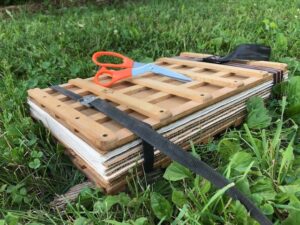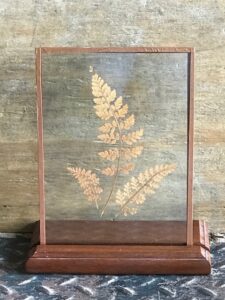Nothing To Do? Press Some Plants
It may be hot and humid out there, but a lot of our favorite plant ancestors came from the tropics and gradually acclimated to also surviving winter, as we have done ourselves. Deep into their tropical Iowa growing season it is interesting to gather some souvenirs to appreciate, come the shorter and darker days of winter. One way to do this is to gather, press and dry some plant specimens now and turn them into household decorations and things to study.
To get started you will need a plant press. The big and bulky version is used by professional botanists for preparing lab and herbarium specimens. It is made of a pair of lightweight wooden slat frames sandwiching a thick package of corrugated cardboard and blotting paper. The pressing is done by tightening the straps.
A smaller lightweight version can be purchased or homemade. It consists of two thin plywood covers clamping down on alternate layers of cardboard and pairs of thin blotting papers. Pressure is provided by slender bolts in the corners with wing nuts for easy tightening.
A simpler homemade press is just a sturdy little flat box containing cut out flat newspaper layers topped with a cover board and weighted down with a brick. If you only want to try pressing a few specimens, just use an old book with porous, not slick, pages. For example, an old telephone book, and weigh it down with a few more books.
Flat thin leaves and slender vines are easy to press and dry. Many fern leaves are nearly two-dimensional already and have a low moisture content. Flat flowers like the pansy are easy to practice with. Avoid flowers that are bulky or succulent. Wait for days that are not real humid and sticky to begin pressing, then keep slowly tightening the press down occasionally for a couple of months.
And then what?
Decades ago my daughter made me a gift of a little fern arrangement she had pressed, dried and mounted between two panes of very thin glass cut from an old window, and held together with a strip of copper foil usually used for mounting stained glass. She also made a polished holder for it from a piece of walnut wood. This delicate fern has lived on my desk since then.

Two pages in my 3-ring notebook of pressed and dried specimens, glued onto file folder material with plastic covers. This notebook has survived handling by several hundred students. Numbered dots key to other pages with notes.
When I was a student in an ecology class some 53 years ago, the professor encouraged us to prepare a notebook of pressed, dried and labeled specimens collected on our field trips. It proved to be a useful reference. I still have mine.
Pressed leaves and flowers sandwiched in glass can be hung in windows or hung like wall pictures, or kept as souvenirs and keepsakes from weddings, vacations or anniversaries. Pressed plants can become the basis for nature artwork and we’ll explore that a bit next week.
So take a little hike around our very green corner of the world and take the time to look closely at the architecture of leaves, vines and small flowers, and consider how you might preserve a bit of it.
Tags: botany, Bur Oak Land Trust, Lon Drake, nature art, plant press




